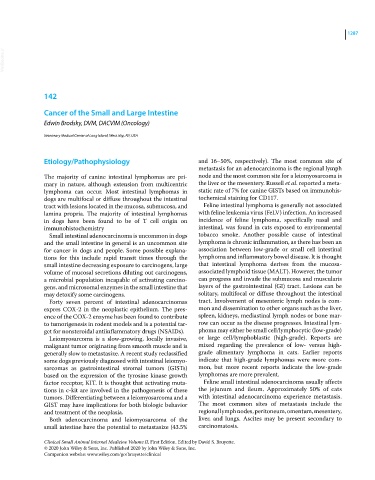Page 1349 - Clinical Small Animal Internal Medicine
P. 1349
1287
VetBooks.ir
142
Cancer of the Small and Large Intestine
Edwin Brodsky, DVM, DACVIM (Oncology)
Veterinary Medical Center of Long Island, West Islip, NY, USA
Etiology/Pathophysiology and 16–50%, respectively). The most common site of
metastasis for an adenocarcinoma is the regional lymph
The majority of canine intestinal lymphomas are pri- node and the most common site for a leiomyosarcoma is
mary in nature, although extension from multicentric the liver or the mesentery. Russell et al. reported a meta-
lymphoma can occur. Most intestinal lymphomas in static rate of 7% for canine GISTs based on immunohis-
dogs are multifocal or diffuse throughout the intestinal tochemical staining for CD117.
tract with lesions located in the mucosa, submucosa, and Feline intestinal lymphoma is generally not associated
lamina propria. The majority of intestinal lymphomas with feline leukemia virus (FeLV) infection. An increased
in dogs have been found to be of T cell origin on incidence of feline lymphoma, specifically nasal and
immunohistochemistry intestinal, was found in cats exposed to environmental
Small intestinal adenocarcinoma is uncommon in dogs tobacco smoke. Another possible cause of intestinal
and the small intestine in general is an uncommon site lymphoma is chronic inflammation, as there has been an
for cancer in dogs and people. Some possible explana- association between low‐grade or small cell intestinal
tions for this include rapid transit times through the lymphoma and inflammatory bowel disease. It is thought
small intestine decreasing exposure to carcinogens, large that intestinal lymphoma derives from the mucosa‐
volume of mucosal secretions diluting out carcinogens, associated lymphoid tissue (MALT). However, the tumor
a microbial population incapable of activating carcino- can progress and invade the submucosa and muscularis
gens, and microsomal enzymes in the small intestine that layers of the gastrointestinal (GI) tract. Lesions can be
may detoxify some carcinogens. solitary, multifocal or diffuse throughout the intestinal
Forty seven percent of intestinal adenocarcinomas tract. Involvement of mesenteric lymph nodes is com-
expres COX‐2 in the neoplastic epithelium. The pres- mon and dissemination to other organs such as the liver,
ence of the COX‐2 enzyme has been found to contribute spleen, kidneys, mediastinal lymph nodes or bone mar-
to tumorigenesis in rodent models and is a potential tar- row can occur as the disease progresses. Intestinal lym-
get for nonsteroidal antiinflammatory drugs (NSAIDs). phoma may either be small cell/lymphocytic (low-grade)
Leiomyosarcoma is a slow‐growing, locally invasive, or large cell/lymphoblastic (high-grade). Reports are
malignant tumor originating from smooth muscle and is mixed regarding the prevalence of low‐ versus high‐
generally slow to metastasize. A recent study reclassified grade alimentary lymphoma in cats. Earlier reports
some dogs previously diagnosed with intestinal leiomyo- indicate that high‐grade lymphomas were more com-
sarcomas as gastrointestinal stromal tumors (GISTs) mon, but more recent reports indicate the low‐grade
based on the expression of the tyrosine kinase growth lymphomas are more prevalent.
factor receptor, KIT. It is thought that activating muta- Feline small intestinal adenocarcinoma usually affects
tions in c‐kit are involved in the pathogenesis of these the jejunum and ileum. Approximately 50% of cats
tumors. Differentiating between a leiomyosarcoma and a with intestinal adenocarcinoma experience metastasis.
GIST may have implications for both biologic behavior The most common sites of metastasis include the
and treatment of the neoplasia. regional lymph nodes, peritoneum, omentum, mesentery,
Both adenocarcinoma and leiomyosarcoma of the liver, and lungs. Ascites may be present secondary to
small intestine have the potential to metastasize (43.5% carcinomatosis.
Clinical Small Animal Internal Medicine Volume II, First Edition. Edited by David S. Bruyette.
© 2020 John Wiley & Sons, Inc. Published 2020 by John Wiley & Sons, Inc.
Companion website: www.wiley.com/go/bruyette/clinical

